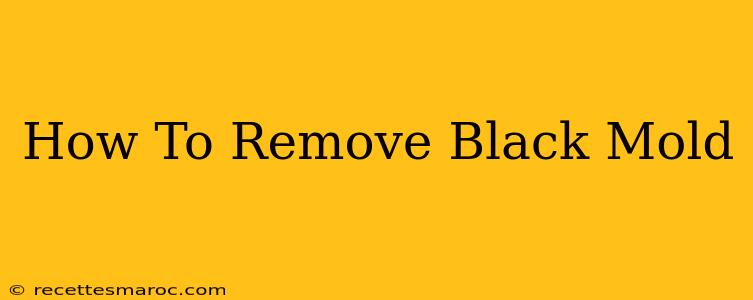Black mold. Just the words themselves conjure images of damp basements and musty smells. But beyond the unpleasant aesthetics, black mold (specifically Stachybotrys chartarum, but often other molds are mistaken for it) poses serious health risks, especially for those with respiratory issues or allergies. This guide will walk you through the process of safely and effectively removing black mold, but remember: if the infestation is extensive (more than 10 square feet), you should always consult a professional mold remediation specialist. DIY solutions are only suitable for small, contained areas.
Identifying Black Mold
Before you start scrubbing, it's crucial to correctly identify black mold. Many dark-colored fungi are mistaken for Stachybotrys chartarum. True black mold often appears slimy or wet and has a musty odor. If you're unsure, it's best to err on the side of caution and call a professional.
Safety First: Protecting Yourself
Working with mold requires taking precautions to protect your health:
- Wear protective gear: This includes an N95 respirator (crucial!), gloves (nitrile is recommended), eye protection, and long sleeves and pants.
- Ventilate the area: Open windows and doors to maximize airflow. Use fans to help circulate air and exhaust mold spores outdoors.
- Contain the area: If possible, seal off the affected area with plastic sheeting to prevent mold spores from spreading.
- Dispose of contaminated materials properly: Double-bag all contaminated materials in heavy-duty trash bags and seal them tightly. Dispose of them according to local regulations.
Removing Small Black Mold Infestations: A Step-by-Step Guide
For small areas of black mold (less than 10 square feet), you can attempt removal yourself, following these steps:
1. Prepare the Area
Thoroughly clean the affected area using a stiff brush to remove loose debris.
2. Apply a Mold Killer Solution
There are many commercial mold killing solutions available. Follow the manufacturer's instructions carefully. A solution of bleach and water (1 part bleach to 10 parts water) is often used, but it's important to test it on an inconspicuous area first to ensure it doesn't damage the surface.
3. Scrub the Affected Area
Use a stiff brush or scrub brush to thoroughly scrub the affected area, paying attention to all crevices and cracks.
4. Rinse and Dry
Rinse the area thoroughly with clean water and allow it to dry completely. Use fans and dehumidifiers to expedite the drying process. Moisture is crucial for mold growth, so thorough drying is paramount.
5. Prevent Future Mold Growth
Address the source of the moisture problem. This might involve fixing leaks, improving ventilation, or reducing humidity.
What to Do After Mold Removal
- Monitor the area: Carefully inspect the area for any signs of regrowth in the following weeks.
- Deep clean: After mold removal, thoroughly clean the entire area to remove any remaining spores.
- Consider professional help: If the mold returns or you encounter difficulties, consult a professional mold remediation specialist.
When to Call a Professional Mold Remediation Specialist
As mentioned earlier, always consult a professional for infestations larger than 10 square feet. Professional remediation services have the equipment, expertise, and safety protocols to handle large-scale mold problems safely and effectively. They can also identify the root cause of the mold growth and implement preventative measures to stop it from recurring. Ignoring extensive mold growth can lead to significant health and structural problems.
This guide provides a general overview of black mold removal. Remember that safety is paramount. Always prioritize your health and seek professional help when needed. The information provided here should not be considered a substitute for professional advice.

